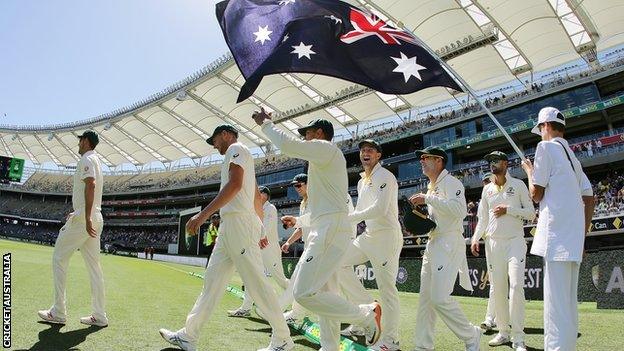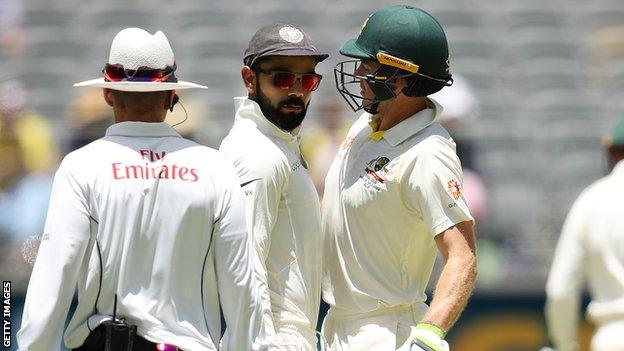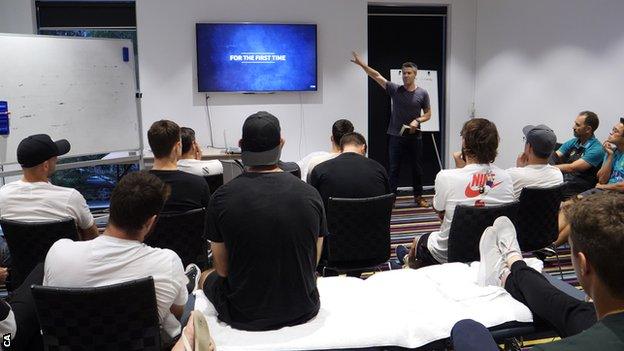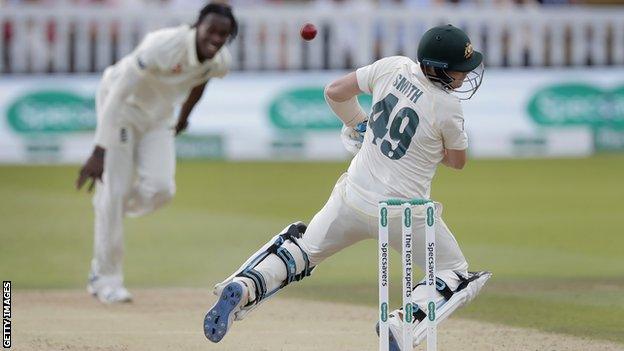Ball tampering, Smith v Archer, Stokes at Headingley - Amazon's Australia documentary
- Published

'The Test', a documentary following the Australia team, is released on Thursday
It begins with the biggest scandal ever to engulf Australian cricket and ends inside the victorious visiting dressing room in one of the most incredible English summers in recent memory.
'The Test', released on Amazon Prime Video on Thursday, gives unprecedented access to the men in baggy green caps as they sought to rebuild their reputation following the ball-tampering scandal.
From an English perspective, seeing Australian players' view of the World Cup win, Jofra Archer's duel with Steve Smith and Ben Stokes' Headingley heroics not only stirs fond memories, it also gives a rare peek behind enemy lines.
If you have an opinion on the likes of Smith, David Warner, captain Tim Paine or coach Justin Langer, then this eight-part documentary is unlikely to change your mind - it is often the cricketers as players rather than characters that is the focus.
And you will probably not relish the Australian Ashes celebrations that bookend the documentary. There are, though, some fascinating morsels to devour.
The Paine-Kohli duel
Fresh from being vilified because of the sandpaper in Cameron Bancroft's trousers, Australia wrestled with how they would approach the series against India, their first home Test matches after the ball-tampering saga.
Langer told the players they could engage in "banter", but not cross into "abuse", while Paine did not want his team to acknowledge India megastar Virat Kohli, in case they either made him too comfortable or spurred him into action.
When Kohli, himself no angel on the field, was at his provocative peak during the second Test in Perth, Langer said he felt like his team were a "punching bag", having to take the grief, but unable to hit back for fear of the public response.
It was Paine who broke his own rule and took a stand against Kohli, coming face to face with the India captain when Australia were batting and later, when he was wicketkeeping, muttering the killer line to Murali Vijay: "I know he's your captain, but you can't seriously like him as a bloke."
Australia won the Test and, in their eyes, found a way to verbally engage with opponents without crossing the all-important "line".

Tim Paine and Virat Kohli came face to face in the Perth Test
Langer's star is born
In many ways, Langer is the star of the documentary. The story begins when he is appointed coach and he has the final word of the last episode.
Langer the player was, frankly, an annoyance to England fans. A man who worshipped at the altar of the baggy green, a rottweiler always in a scrap and, most frustratingly, regularly piling on Ashes runs.
Langer the coach is honest, passionate, and rarely smiling. Therefore, an early eyebrow-raising moment is when he enthuses about the Lady Gaga movie A Star Is Born (although he does later admit "it's not nearly as good" on a small screen).
At home in Perth, Langer spends his mornings swimming in the ocean and meditating. When he is seen kissing a statue of Buddha as he leaves the house, it fits with the character who encouraged his team to walk barefoot on the Edgbaston outfield before the World Cup semi-final against England.
He reveals that his wife burst into tears over breakfast during the Sydney Test against India, such was the strain he was under, and later recalls the Facetime exchange they had as he drank scotch on the night of Stokes' Headingley performance for the ages.
"You don't drink scotch."
"I do tonight, baby."
It was that Sunday at Headingley that will perhaps provide English viewers with their most satisfying moment of the series.
After Nathan Lyon fumbled a run out that would have won the Test, Langer dishes out a brutal kick to a bin, only to then sheepishly collect the scattered rubbish from the floor.
Player insight
In a documentary about a cricket team, there is, understandably, a heavy focus on the cricket itself.
And, while being able to see what goes on in team meetings is interesting, the thinking behind the decision to attack England with left-arm pace during the World Cup, or why Warner doesn't like to net too much in the lead-up to games isn't exactly juicy gossip.
It is when the players talk about themselves, rather than their techniques, that the best moments come.
Off-spinner Lyon, the man who once said he wanted to "end the careers" of England players, is shown to be incredibly nervous, even to the point that his own team-mates tease him about it. When he is waiting to bat during the Archer-Smith battle at Lord's, his palms are so sweaty he asks if someone has "turned a tap on".
Leg-spinner Adam Zampa describes how his love for coffee is so deep that when he is preparing to go on tour, he packs his brew-making equipment first, then adds clothes if there is room. All-rounder and close mate Marcus Stoinis will join Zampa in his hotel room for coffee, in what they call the 'Love Cafe'.
The bromance between batting master Smith and his apprentice Marnus Labuschagne was already well known, but not the fact that the untidy Smith promised to give Labuschagne one of his bats if the rookie tidied the senior man's kit at the end of every Ashes Test.
Labuschagne called it "one of the best deals of the summer".

The Test gives an insight to a number of Australia team meetings and how tactical plans were formed
Australia revelled in Edgbaston atmosphere
From an England perspective, the real meat comes in the final two episodes, which cover the dramatic, fluctuating and action-packed Ashes series.
Beforehand, there are nods to the reception that the tourists will receive in the first Test at Edgbaston, especially during their opening World Cup game against Afghanistan at Bristol, when Ricky Ponting says he and Langer were "holding each other back" from climbing into the stands and confronting members of the crowd.
However, on the whole, Australia dealt with the sandpaper-related flak from the febrile Birmingham crowd incredibly well, starting with Paine's incredulity at being asked about how intimidating Edgbaston is as a venue for visiting teams.
Although Langer admitted that the abuse his team received was actually worse outside the ground than inside it, Australia reacted to the insults, hand gestures, chants and signs aimed at their team bus by singing along, clapping and waving. They actually enjoyed it.
Come the fourth morning, by then on the way to his second century of the match, Smith sang along to England anthem Jerusalem as he waited to bat.
On the fifth day, with his side on the verge of victory, Paine was able to enjoy the silence of the home crowd. Whereas before the wicketkeeper was unable even to hear his slip fielders, he was now able to have a conversation with the men at mid-on and mid-off.
Lord's theatre
The most gripping passage of the entire documentary is the account of the fourth afternoon of the second Test, when Archer floored Smith with a brutal bouncer, only for Smith to return to the crease.
It is like going backstage at the most engrossing drama, only this is played out in real time, without a script, all with the spectre of the Phil Hughes tragedy hanging over the proceedings.
As Smith lay on the ground, Warner quietly told Langer that the world's best batsman was struck in the exact spot that had previously proved fatal for Hughes.
Smith describes how that was not, in fact, the case, and goes on to talk of his guilt at being able to walk off the pitch when Hughes had not been so fortunate.

Steve Smith was concussed when hit by a delivery from Jofra Archer during the Lord's Test
In the words of Mitchell Marsh, the Australia dressing room was "panic stations" and although Smith was deemed fit to bat on at the fall of the next wicket, when he was eventually dismissed he returned to the dressing room, hurled his bat, slumped into his seat and was barely able to lift his head.
With Smith then ruled out of the rest of the match with concussion, his replacement Labuschagne was struck on the grille by Archer from the first delivery he faced. As that sickening blow is shown in slow motion, the head-in-hands reaction of Stokes, fielding in the background, perfectly encapsulates the shock, fear and tension of the moment.
The Headingley response
Amid the home euphoria of Stokes winning the Headingley Test from a near-impossible position, it was easy to overlook the fact that Australia had suffered one of the most bruising defeats in Ashes history.
As Stokes was laying waste to the Australian attack, Langer's frustration was clear, with the coach unable to understand why his team were not working harder to starve the England all-rounder of the strike.
When the beaten tourists returned to the dressing room in silence, Lyon, who had fluffed the opportunity to run out Jack Leach, was inconsolable, sitting with his head covered by a towel.
It was left for the impressive Paine to address his team. "That's going to hurt for a couple of days," he said. "But we've still got two Test matches. Let this sting, but we had chances to win this game. It happens. Keep knowing that the process we have to beat these blokes is going to work."
The next day, after that rare glass of scotch, Langer called the entire squad together to watch the last hour of the match, much to the chagrin of the crestfallen Lyon.
"This could easily break us," said Langer, who then, in front of the rest of the team, questioned Paine on his plans and field-settings for Stokes.
At the end of the meeting, they agreed to move on. At a tour match in Derby, they released some frustrations with a game of touch rugby and bonded over Marsh's regular morning walks to a coffee shop.
When they next faced England, in the fourth Test at Old Trafford, Australia earned the win that retained the Ashes.